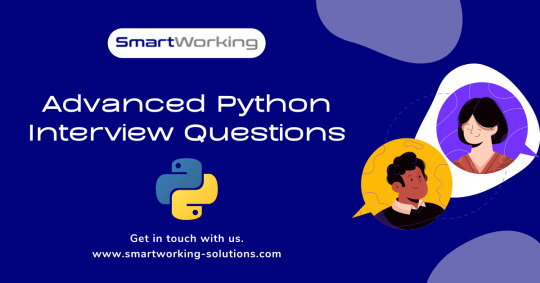#remotepythondeveloper
Explore tagged Tumblr posts
Text
Advanced Python Interview Questions
Besides coding knowledge, hiring managers look at candidates’ ability to answer complex questions and think on their feet. They look for the certainty that developers are agile and will not duplicate functionalities.

Below, we list a few python advanced interview questions and answers that candidates can prepare for interviews.
1. What are virtualenvs?
Answer: Remote Python developers refer to a virtualenv as an isolated environment to develop, run, and debug Python code. You can achieve this by isolating a Python interpreter, together with a set of libraries and settings. Alongside pip, virtualenvs helps developers run and deploy many applications on a single host. Each one contains a Python interpreter version and a separate set of libraries.
2. What are the Wheels and Eggs? What is the difference?
Answer: Wheel and Egg are packaging formats that support the use case of needing an install artefact without building or compilation – otherwise costly in testing and production workflows. Setuptools introduced the Egg format in 2004, while PEP 427 introduced the Wheel format in 2012. Wheel is the current standard for built and binary packaging for Python programming language.
3. What are the usages of nonlocal and global keywords?
Answer: Developers use the nonlocal and global keywords to change the scope of a previously declared variable. Developers use nonlocal to access a variable in a nested function. On the other hand, global makes a previously-declared variable global. It’s a relatively straightforward function.
4. What is the function of self?
Answer: As a variable, self represents the instance of the object to itself. Typically, most object-oriented programming languages pass on this method as a hidden parameter defined by an object. However, in Python programming language, the variable isn’t implied. It is declared and passed explicitly. It is the first argument created in the instance of the class A. Consequently, the parameters to the methods are passed automatically.
5. What is the difference between classmethod and staticmethod?
Answer: Both refer to a class method that can be called without instantiating an object of the class. The only difference lies in their respective signatures.
6. What is GIL? What are the ways to get around it?
Answer: GIL or Global Interpreter Lock is a mechanism Python uses for concurrency. One of its biggest drawbacks is that it locks the interpreter, making concurrent threading difficult. The process can result in major performance losses.
7. What are metaclasses, and when are they used?
Metaprogramming in Python is a vast and intriguing topic. Metaclasses refer to classes for classes. A metaclass can ascertain a common behaviour for many classes – specifically in cases when inheritance will get messy. An example of a metaclass is ABCMeta, which creates abstract classes.
8. What are generator functions?
Generator functions can suspend their execution after returning a value. They resume at a later time and return another value. Use the yield keyword instead of return to make this possible.
9. What are decorators in Python Programming?
Python developers use decorators to modify the behaviours of functions. Decorators come prefixed with the @ symbol and placed right before a function declaration.
10. What is pickling and unpickling in Python?
Pickling is another word for serializing. Pickling is a process that allows you to serialize an object into anything you choose – a string, for instance. The function enables objects to be persisted on storage or sent over the network. On the other hand, unpickling restores the original object from a pickled string.
0 notes